|
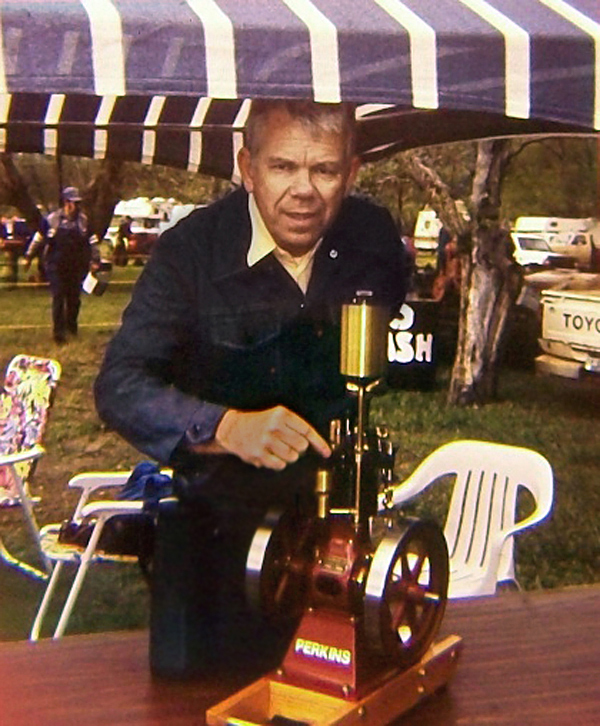
|
From the Internet Craftsmanship Museum:
Jerry Howell has been well known in the model
engineering hobby for a number of years. He attends the NAMES show and
a number of other shows almost every year with a beautiful display of
engines he has designed. The engines he has designed no doubt grace
many a desk or mantel of proud builders around the world. One look at
the finishes on his personal projects will tell you he is not satisfied
with any result less than perfection—they are truly beautiful. More
important to us at the Foundation, however, is the fact that he takes
the extra step beyond just making engines to that of designing and
producing plans and kits so that others can make them as well. Even his
plans go an extra step not usually found in engine kits, and that is to
show complicated parts at several stages of completion, making it
easier for a novice to take a raw block of metal to a finished engine
block. We were impressed enough with Jerry’s newest project to make the
Howell V-4 our next museum shop project. You can follow along as we
build it by going to the build
page.
|
A Model Builder from an Early Age
Jerry Howell was born and
raised in West-central Ohio. From a very early age he was interested in
mechanical things and especially things in miniature. It wasn't until
he was in his 50's that he found out where that trait probably came
from. His Dad told him of his grandfather who had built
a scale model of a house he was going to build. The model
included all the studs, rafters, etc. He then used the refined and
proven model as the plans to build his full size house.
Having had several electric train sets while
growing up created a fascination with steam locomotives. From
Jerry’s early teen years in the early 1950's he was always
into making box kites, wooden ship models, electric boats, balsa wood
gliders, rubber powered model airplanes, water pipe/firecracker
guns and soda straw/black powder rockets. Some of the soda
straw rockets had two or three stages and flew to several hundred feet
high. In metal shop class he turned a brass naval canon barrel which
developed into an interest in machining. He checked out every book
about steam engines, rockets/jets, astronomy and telescope
making from the library at least a half dozen times. His best school
subjects were physics and chemistry. Looking back, he says that he is
positive that all those things together had a large influence on what
he did later on.
After high school Jerry went to work for his father
driving one of his trucks picking up milk in 10 gallon cans
from farms 7 days a week. As a young adult he was into flying control
line model planes, and then later on, R/C planes and boats for
a while. Acquiring a 3" Unimat lathe in 1960 rekindled an
interest in machining and he used it to build fuel filters and
several throttles for his two-stroke engines in order to
improve idle reliability over the crude ones available at the time.
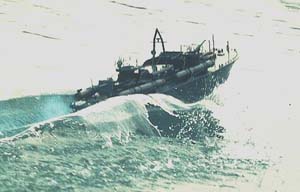
(Click image for larger view.)
Jerry built this radio-controlled model of PT-109 in 1968. It was built
from a Fibo Craft kit. The hull is fiberglass and the major deck
structures are wood. Deck details are white metal castings and the
torpedo tubes are aluminum tubing with red painted ping pong ball
noses. The boat is 39" long and weighs around 10 pounds. It is powered
by one of the first O.S. Wankel engines of the time. The engine is .29
cubic inch (about 5 cc) displacement and is fitted with a stainless
steel flywheel and a brass water jacket. A water pick-up is fitted
behind the propeller and after circulating through the engine jacket,
cooling water discharges into the exhaust pipe ahead of the muffler.
The tailpipe exits through the transom. A little whiff of white castor
oil smoke and steam vapor can be seen in each photo. There are two 8
ounce fuel tanks, one on each side of the prop shaft stuffing tube. A
fuel pump is belt driven from the prop shaft.
A Career Change Puts Machine Tools Back into
His Life
Jerry never cared much
for driving the truck, so when the opportunity came in 1962,
he took a job in Jacksonville, Florida as an apprentice making plastic
injection molds for a few years. Here he learned a lot about machining
and operating full size lathes, mills, other machines. During
that time he made his first engine—a little 1/4" bore oscillating steam
engine from bar stock at home on the kitchen table.
After a few years, he moved
back to Ohio and eventually bought and operated a construction
equipment business. Here his main hobby interest turned to HO model
trains for a couple of decades. His scratch built 0-6-0 switch
engine was an early Model Railroader magazine
Model-of-the-Month winner.
Getting into the Computer Business Adds
Computer Drawing Skills to His Repertoire
Selling the construction
equipment business and opening a computer store in the early 1980's,
Jerry learned about CAD software and has been using Drafix CAD
Ultra in designing his own projects ever since. He says he
would not have wanted to do most of
his projects without the use of CAD software.
In the mid 1980's he became
interested in "hot-air" engines, both the
atmospheric and the Stirling cycle. He
began building many types of these engines and as he went along found
that he enjoyed designing engines as much,
or more, than building and running them.
Requests from Friends Lead to a
Business Selling Kits and Plans
Beginning with the early NAMES
shows others were asking for plans to build Jerry’s
engines. He came by a used 1904 book showing wood
cuts of those beautiful late 1800's Victorian era large stationary
steam engines that really caught his
fancy. He started incorporating that Victorian style
into his engines, concentrating on esthetics. He began
designing his bar stock engines to look as much like
they were made from castings as possible and still not be too difficult
for the average builder to make. He notes that a pleasing model that is
to the eye only takes a little longer to build than a bare bones one,
and if it was worth doing at all, one should make it look as
nice as possible. Really well done models will become valued heirlooms
to be handed down long after the builder is gone.
There were a
few scale engines that Jerry wanted to make that just
couldn't be manually machined from solid stock and still look like they
were made from castings. Many of the parts were very small, so sand
casting was out. The answer was making lost wax castings. A jeweler
friend taught him the very involved process, and with the purchase of a
lot of high priced equipment, he made several detailed limited edition
castings kit engines in aluminum and also in zinc alloy. His favorite
of these is the "1 of 50" serial numbered Rider Compression
Hot-Air Pumping Engine which is now a collector’s item.
After designing so many of the
"hot-air" engines his interest turned to internal combustion engines.
Having acquired larger machine tools over the years, Jerry decided to
buy and build some antique model hit-n-miss IC and steam engine
castings kits. Over time, he has collected more than 25 of these kits
and has built some of them, with the rest being saved for "some
day". These kit engines inspired him to develop some
of his own bar stock IC engines. He saw there was a relative
lack of non-airplane type IC bar stock engines in the hobby, so he
turned his attention to that area. The first ones were single cylinder
and later came the air cooled 90-degree V-Twin and the liquid
cooled V-Four which features twin cams, Hall effect distributor,
pressure feed oil system, magnetic drive water pump and a water heated
intake manifold.
Jerry has always wanted his IC
engines to be doing something instead of running without a purpose.
Others have geared or belted their engines to can crushers, peanut
roasters, water pumps, etc., but having a fondness for stationary
industrial engines, he decided that a generator was about as
practical and clean a load that can be driven by a model engine. Also,
a permanent magnet generator (actually a DC motor) doubles as
a starter motor. All of the prototype internal combustion engines he
has designed since 1995 have the starter/generators as standard
equipment. They have sort of become his "trademark" engines at shows.
Over the years Jerry has attended more than 50 model engineering shows
and has met some of the finest folks on earth, and more than a few have
became close friends. Model engineering/machining is truly
one of the world's great hobbies!
Jerry’s project,
the "Howell V-Four" engine is currently the Foundation
Craftsmanship Museum Group Build project which he considers a
great honor.
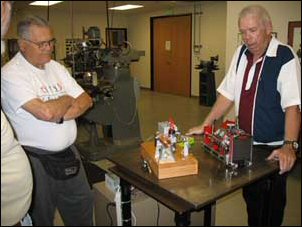 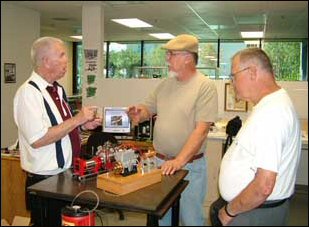
Jerry visits with founder Joe
Martin and shop craftsman Tom Boyer on a visit to the Craftsmanship
Museum. (Vista, California / October, 2007.)
Jerry's Shop
Jerry owned an original 1960
Unimat DB200, although it had only been used with a buffing wheel for
polishing for the past 20 years. He also owned a Maximat 7 and Maximat
Super 11 lathe. In the mill department he used a Jet JVM-836 (manual
with Mitutoyo DRO and 6" Kurt Vise), and a Jet JVM-836 mill
that he converted to CNC with ball screws. The conversion was done in
January, 2007. His first CNC project was to mill the skids and the
exhaust rain caps for the Howell V-4 engine. He used either one of the
mills for drilling large holes, and his own Mini Drill Press for
everything under 1/4". There is also a cantankerous old Jet 5"
horizontal/vertical bandsaw that he always threatened to take
a sledge hammer to!
|
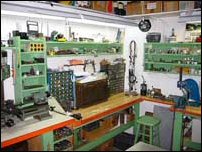
|
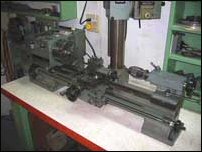
|
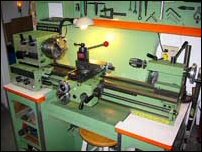
|
|
An Overall View of Jerry's 10 x 14' Shop
|
1968 Emco Maier Maximat 7 Small Gearhead Lathe
|
1990 Emco Maier Maximat Super 11 Lathe
|
Jerry's Personal Projects
(Click Images for larger view.)
Plans & Parts
| Ignition Systems | Bearings | Misc. Items | Boehm
Engine Kits
Contact Us | Catalog | Comments | Links | Forum | Model
Engineering Tips
| On the Road | Tribute
to Jerry
Copyright © 2010
Outpost Enterprises LTD. All Rights Reserved.
|